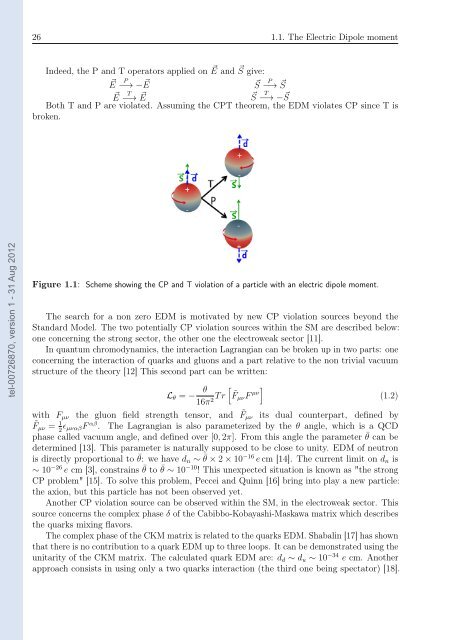Développement et optimisation d'un système de polarisation de ...
Développement et optimisation d'un système de polarisation de ...
Développement et optimisation d'un système de polarisation de ...
You also want an ePaper? Increase the reach of your titles
YUMPU automatically turns print PDFs into web optimized ePapers that Google loves.
tel-00726870, version 1 - 31 Aug 2012<br />
26 1.1. The Electric Dipole moment<br />
In<strong>de</strong>ed, the P and T operators applied on E and S give:<br />
E P<br />
−→ − E S P<br />
−→ S<br />
E T<br />
−→ E S T<br />
−→ −S Both T and P are violated. Assuming the CPT theorem, the EDM violates CP since T is<br />
broken.<br />
Figure 1.1: Scheme showing the CP and T violation of a particle with an electric dipole moment.<br />
The search for a non zero EDM is motivated by new CP violation sources beyond the<br />
Standard Mo<strong>de</strong>l. The two potentially CP violation sources within the SM are <strong>de</strong>scribed below:<br />
one concerning the strong sector, the other one the electroweak sector [11].<br />
In quantum chromodynamics, the interaction Lagrangian can be broken up in two parts: one<br />
concerning the interaction of quarks and gluons and a part relative to the non trivial vacuum<br />
structure of the theory [12] This second part can be written:<br />
Lθ = − θ<br />
<br />
T r ˜FµνF<br />
16π2 µν<br />
<br />
with Fµν the gluon field strength tensor, and ˜ Fµν its dual counterpart, <strong>de</strong>fined by<br />
˜Fµν = 1<br />
2 ɛµναβF αβ . The Lagrangian is also param<strong>et</strong>erized by the θ angle, which is a QCD<br />
phase called vacuum angle, and <strong>de</strong>fined over [0, 2π]. From this angle the param<strong>et</strong>er ¯ θ can be<br />
d<strong>et</strong>ermined [13]. This param<strong>et</strong>er is naturally supposed to be close to unity. EDM of neutron<br />
is directly proportional to ¯ θ: we have dn ∼ ¯ θ × 2 × 10 −16 e cm [14]. The current limit on dn is<br />
∼ 10 −26 e cm [3], constrains ¯ θ to ¯ θ ∼ 10 −10 ! This unexpected situation is known as "the strong<br />
CP problem" [15]. To solve this problem, Peccei and Quinn [16] bring into play a new particle:<br />
the axion, but this particle has not been observed y<strong>et</strong>.<br />
Another CP violation source can be observed within the SM, in the electroweak sector. This<br />
source concerns the complex phase δ of the Cabibbo-Kobayashi-Maskawa matrix which <strong>de</strong>scribes<br />
the quarks mixing flavors.<br />
The complex phase of the CKM matrix is related to the quarks EDM. Shabalin [17] has shown<br />
that there is no contribution to a quark EDM up to three loops. It can be <strong>de</strong>monstrated using the<br />
unitarity of the CKM matrix. The calculated quark EDM are: dd ∼ du ∼ 10 −34 e cm. Another<br />
approach consists in using only a two quarks interaction (the third one being spectator) [18].<br />
(1.2)

















